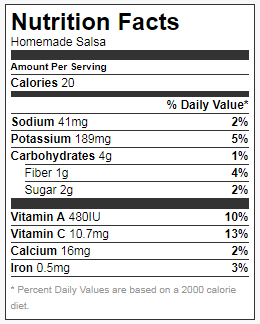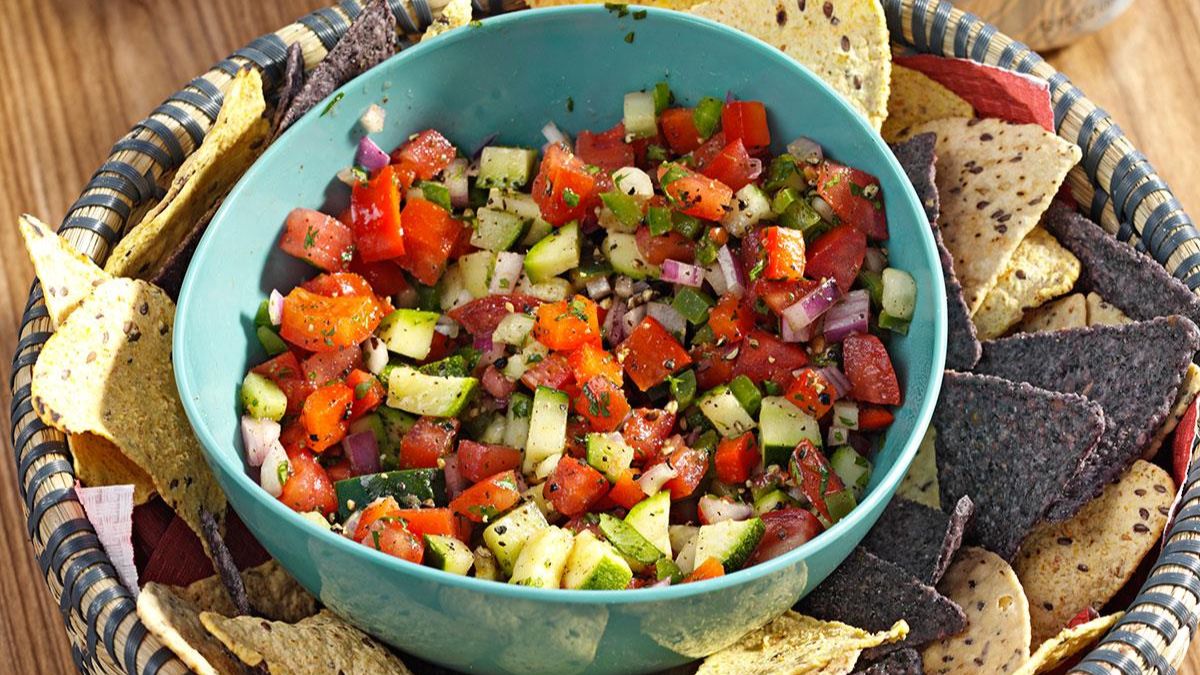Most salsa starts with tomatoes, but you can also use other vegetables or fruits. Mango salsa is a newer dish that has become very popular. It uses mainly the same ingredients, but instead of diced tomatoes, it uses cubed mango. Peach salsa and tomato-based recipes with black beans and corn are also exciting ways to change the dish. It has some hot pepper, the only thing they all have in common. The amount of heat is, of course, up to the cook.
Homemade Salsa Nutrition Facts

How to Make the Best Salsa?
A super easy, super fresh, super delicious salsa. You’ll never need another salsa recipe again!
Ingredients
- 1 1/4 lbs ripe Roma tomatoes (about 5 – 6)
- 1 (14.5 oz) can of petite diced tomatoes
- Two green onion ends trimmed, chopped into thirds
- 1/3 cup chopped red onion (about 1/4 of a medium)
- One jalapeno pepper, seeded and roughly chopped
- 1/3 cup fresh cilantro (about a handful)
- One large clove of garlic, roughly chopped
- 2 Tbsp fresh lime juice
- 1/2 tsp chili powder
- 1/4 tsp ground cumin
- 1/2 tsp granulated sugar (optional)
- Salt and pepper to taste
Instructions
- All ingredients should be put into a food processor and pulsed for 1 second at a time until they are all finely chopped.
- Serve with chips made of corn. Remember that salsa always tastes best after it has been in the fridge for a few hours. If you have time, let the flavors combine before serving.
- Store in refrigerator for up to 1 week.
Notes
- Use only the best tomatoes, or the salsa won’t taste good.
- You can also use canned tomatoes with mild green chilies or canned fire-roasted tomatoes.
- If you want the onion flavor to be a little more robust, leave out the green onions and use about 3/4 cup of red onion (or 1/2 of a medium onion).
- You can leave the seeds in spicy salsa or use a serrano pepper.
- I sometimes use a few chipotle peppers in adobo sauce instead of jalapeno. This is another option with more heat.
- You can add 1/2 of bell pepper, one poblano pepper, or 1 Anaheim pepper.
- If you want your salsa to be less thick, add a bit of tomato juice or tomato sauce.
What are the Benefits of Salsa?
Due to the ingredient profile, salsa offers several nutritional benefits.
1) Offers a Good Nutrition Profile
Salsa has a low number of calories, but it still has a lot of vitamins and minerals. Based on the NCC Food and Nutrient Database, the tables below show the total nutritional value of salsa.
2) High in Vitamin C
The nutritional values show that salsa has more vitamin C than other nutrients. There is 17.6 mg of vitamin C in every 100 grams of salsa, which is 29.5 percent of the daily value (recommended intake). Vitamin C is essential for making and fixing blood vessels, collagen, skin, teeth, and more in the body. The vitamin also has antioxidant properties that can help reduce oxidative stress and damage caused by free radicals.
3) Salsa is One of the Best Sources of Lycopene
Lycopene is a carotenoid found in foods with red flesh, like grapefruit and tomatoes. Tomatoes have the most lycopene of these foods. Studies show that lycopene might benefit your health in many ways. Some of these are;
Research shows that adding more lycopene to your diet can make your skin more resistant to UV rays. Systematic reviews and meta-analyses suggest that lycopene may help lower the risk of prostate cancer. More reviews of the existing research, including periodic reviews, indicate that a higher intake of lycopene may reduce the risk of metabolic syndrome and heart disease. Raw tomatoes don’t have a lot of lycopene, which is notable. Also, studies show that cooked or processed tomatoes have a much more significant effect on the blood’s lycopene levels than fresh tomatoes. Since salsa usually uses cooked tomatoes, it is a great way to get lycopene into your diet.
4) Salsa is Delicious, and it’s one of the Healthiest Condiment Choices
Salsa tastes excellent because it has tomato, onion, herbs, chili peppers, and salt. Also, unlike most condiments, traditional salsa recipes are based primarily on foods that haven’t been processed. In other words, salsa isn’t like most condiments because it doesn’t have added sugars or a lot of oil. Because of this, salsa is a better choice for your health than most other famous sauces.
What are the Best Ways to Use Salsa?
On the bright side, salsa can be made and eaten in many easy, healthy, and tasty ways.
As a Sauce for Meat-Based Dishes
There are a lot of different sauces that go well with meat-based dishes. But we can do the same thing with salsa, which is probably much healthier than the most common sauces. To use salsa this way, we need to heat it on the stove and pour it over our food. This is a straightforward way to use condiment, and it can make any dish taste better.
Salad Dressing
Salsa can add much flavor to a salad instead of the usual oil-based salad dressing. Most store-bought salad dressings are full of sugar and vegetable oil, so this way of using salsa can also make a salad healthier.
As a Dip
People often eat salsa with tortilla chips as a dip. But there is no limit to how many different foods we can eat with. For example, here are some foods that go well with a salsa dip;
Also, salsa could be a side-serving alongside almost any meal – it will add a good amount of flavor to most foods.
What are the Varieties of Salsa?
This type of salsa also comes in three different variations;
Salsa adada: The ingredients are roasted in a pan made of cast iron and then ground or blended.
Salsa cruda: The ingredients for this salsa are cut up and mixed, then served raw.
Salsa cocoa is ground after everything has been cooked together on the stove.
What are the Potential Drawbacks?
Even though salsa can be very healthy, not all store-bought salsas have the best mix of nutrients. Other things could be a problem.
1) Some Salsa Products Contain Unhealthy Ingredients
The tomatoes in traditional salsa give it its sweetness, but some store-bought versions add a lot of sugar or corn syrup. Some salsa products also have vegetable oils that aren’t needed. These ingredients are cheap fillers, and salsas that care about the traditional recipe (and your health) won’t have them. In short, check the label to see what’s in something before you buy it.
2) High Salt Content (Sodium)
Salsa is not a good choice for people on low-salt diets because it has more than 330 mg of sodium (or 825 mg of salt) per 100 grams. There is nothing inherently wrong with salt; sodium is an essential mineral that our bodies need and uses in many ways. But for people who are “salt-sensitive,” a lot of salt can significantly raise their blood pressure. So, people who are sensitive to salt might want to look for salsas that are “low salt.” There are many places to buy these things.
3) The Health Merits of Salsa Depend on What you Eat it with
Salsa is pretty healthy, but what we eat it with makes a difference. Tortilla chips are probably the most common thing to eat with salsa, but they aren’t the healthiest option. On the other hand, salsa can be a tasty and healthy addition to the main dish.
4) Food Poisoning (Raw Salsa)
Most of the time, salsa is very safe to eat and rarely makes people sick. But there have been some cases of food poisoning linked to the raw (crude) sauce version.
The Foodborne Disease Outbreak Surveillance System (FDOSS) at the Centers for Disease Control and Prevention found that salsa or guacamole was the cause of more than 136 foodborne disease outbreaks between 1973 and 2008.
Also, it is thought that 5,658 people got sick because of these 136 outbreaks. Salmonella bacteria can live and grow in salsa that hasn’t been stored and cooled correctly, according to studies. Salads already made or in a package are known to be a source of foodborne illnesses like salmonella. It is essential to keep things clean and store them correctly during production. Still, it’s important to note that millions of people eat salsa every year without getting sick, so these cases of food poisoning are rare.
Conclusion
One of the best things about salsa is that it is good for you. It has vitamin C and all the good things that tomatoes are known for. Plus, it doesn’t have many carbs, fat, or cholesterol. A typical serving has about 20 calories, much less than the average in French onion dip. So, it’s a healthy snack that also tastes good. It’s easy to make at home, and any chef who tries it will be happy with the results.

